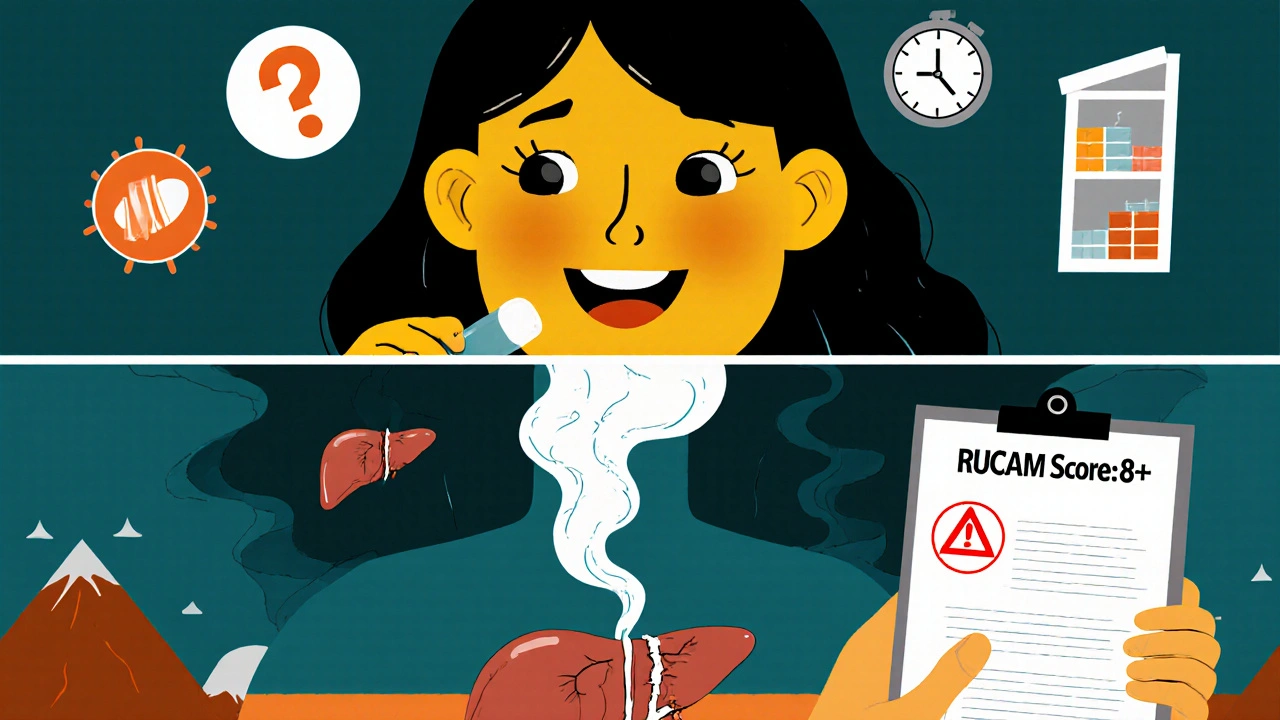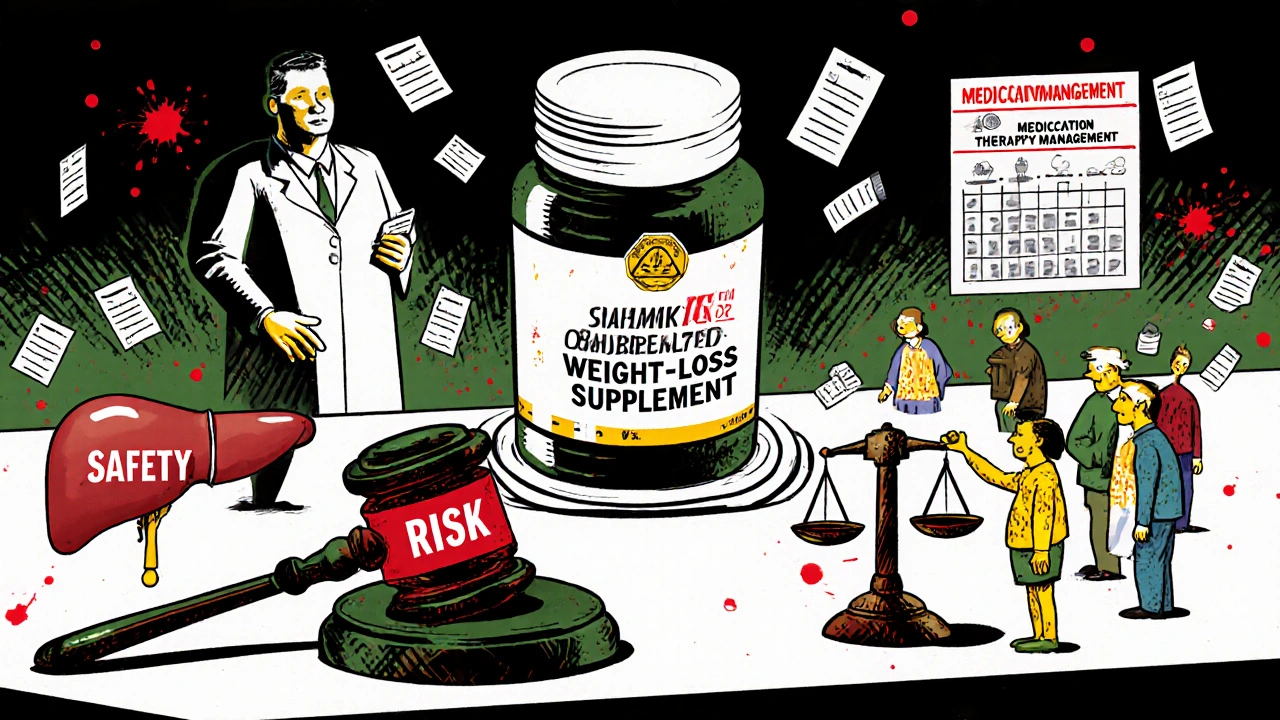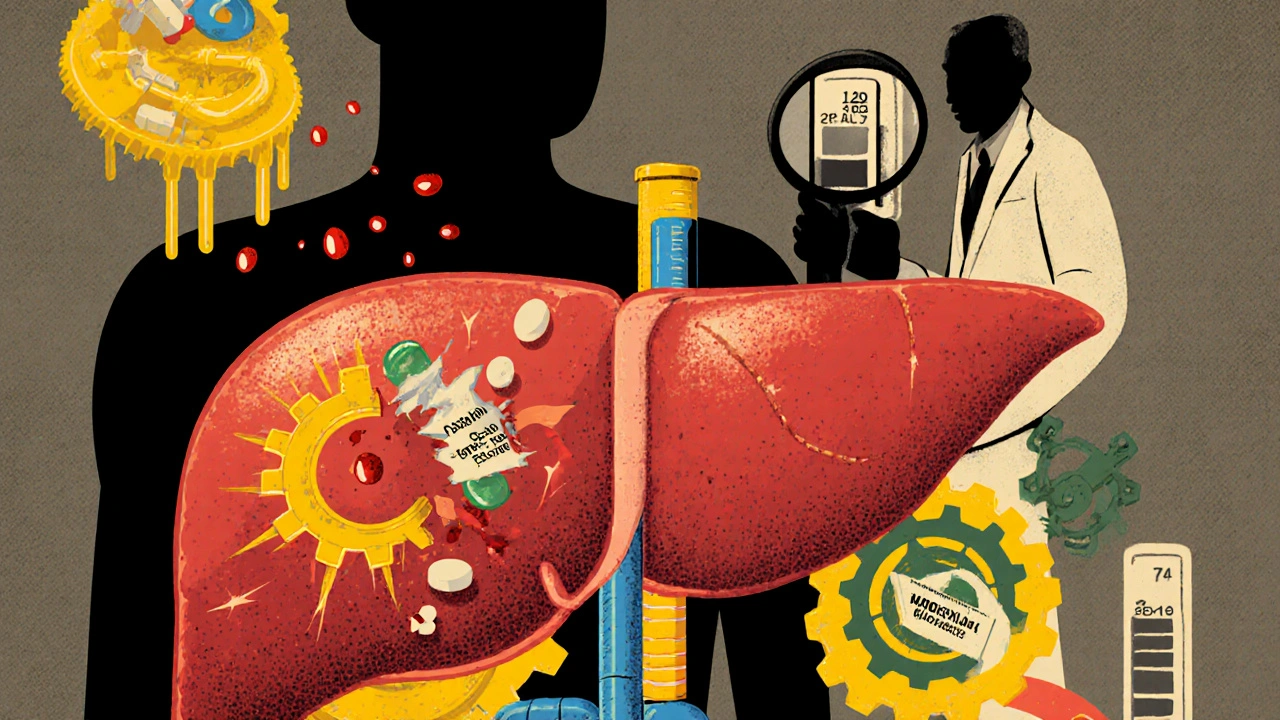Every year, thousands of people end up in the hospital not because of a virus or bad diet, but because of something they took to feel better. Drug-induced liver injury (DILI) is one of the most dangerous side effects of medications - and it often shows up too late. The liver doesn’t scream when it’s hurt. It whispers. By the time symptoms like yellow skin, dark urine, or constant fatigue appear, damage may already be severe. And here’s the scary part: you might not even know you’re at risk.
What Exactly Is Drug-Induced Liver Injury?
DILI happens when a medication, herbal supplement, or even a vitamin harms your liver. It’s not the same as alcohol damage or hepatitis. This is damage caused by something you swallowed - something meant to help you. The liver processes almost everything you take. That’s its job. But sometimes, the process turns toxic. Metabolites build up. Immune cells get confused. Cells die. And if it’s not caught early, the liver can’t recover.
There are two main types. The first is intrinsic - predictable, dose-dependent, and usually linked to one drug: acetaminophen. Take too much, and your liver will fail. The second is idiosyncratic - random, unpredictable, and far more common. It can strike someone on a normal dose of an antibiotic, with no warning. About 75% of all DILI cases fall into this category.
Top High-Risk Medications You Need to Know
Not all drugs carry the same risk. Some are far more dangerous to the liver than others. Here’s what the data shows:
- Acetaminophen - This is the #1 cause of acute liver failure in the U.S. A single overdose of 7-10 grams can kill liver cells. Even regular doses over time - especially in people who drink alcohol or are older - can cause harm. The max safe dose is now 3 grams per day for many adults, not the old 4 grams.
- Amoxicillin-clavulanate - This common antibiotic for sinus infections and ear infections is the leading cause of idiosyncratic DILI. It affects about 1 in every 2,000 to 10,000 people who take it. Symptoms can show up weeks after finishing the course.
- Valproic acid - Used for seizures and bipolar disorder, this drug can cause liver damage in 0.5-1% of users. The risk is highest in kids under 2, especially if they’re on multiple seizure meds. Fatality rates in severe cases hit 10-20%.
- Isoniazid - A key drug for tuberculosis, it causes liver injury in about 1% of adults. That number jumps to 2-3% if you’re over 35. Many patients don’t know they’re at risk until their ALT levels spike to over 1,200 - normal is under 40.
- Herbal and dietary supplements - Green tea extract, kava, anabolic steroids, and weight-loss products now cause about 20% of DILI cases in the U.S. That’s up from just 7% in the early 2000s. People think “natural” means safe. It doesn’t.
Statins? They’re usually fine. Less than 0.002% of users get serious liver injury. But if you’re on multiple drugs - especially with high blood pressure or diabetes - the combo can tip the scale.
How Doctors Spot DILI - And Why It’s So Hard
There’s no single test for DILI. It’s a diagnosis of exclusion. That means your doctor has to rule out everything else first: viral hepatitis, autoimmune disease, fatty liver, gallstones. That takes time. And time is what you don’t have.
The clues come from blood tests. Two numbers matter most: ALT (alanine aminotransferase) and ALP (alkaline phosphatase). If ALT is more than 3 times the upper limit of normal, it’s likely your liver cells are dying. If ALP is more than 2 times normal, bile flow is blocked. The pattern tells the story.
Doctors use a tool called RUCAM - the Roussel Uclaf Causality Assessment Method. It scores everything: timing, dose, other causes, re-exposure. A score of 8 or higher means DILI is “highly probable.” But here’s the catch: most patients don’t get tested until they’re already sick. By then, the damage is done.
Hy’s Law is another critical warning sign. If your ALT is over 3x ULN and your bilirubin is over 2x ULN, you have a 10-50% chance of acute liver failure. This rule was discovered in 1978, and it’s still one of the most reliable predictors we have.

Who’s at Risk - And Why You Might Not Realize It
Women make up 63% of DILI cases. People over 55 are most affected. But risk isn’t just about age or gender. It’s about what else you’re taking.
One patient in Melbourne, 58, took a cholesterol pill for a year. No symptoms. Then, out of nowhere, he turned yellow. It took four doctors and three months to connect it to his statin. He wasn’t on any other meds. No alcohol. No known liver disease. Just a common drug - and his body reacted.
Another woman, 45, took amoxicillin-clavulanate for a sinus infection. Three weeks later, her skin itched nonstop. Her eyes turned yellow. She thought it was allergies. Her doctor thought it was gallstones. It took months to realize it was the antibiotic. She still has mild liver scarring today.
And then there’s the supplement user. A man in his 40s started a “natural” weight-loss product. He lost 15 kilos in two months. Then he got sick. His liver enzymes were through the roof. The product? Green tea extract - a supplement marketed as “healthy.”
It’s not about being careless. It’s about how little we’re told. Many patients don’t know their meds can hurt their liver. And doctors - even good ones - don’t always think to ask about supplements or recent prescriptions.
How to Monitor Your Liver - Practical Steps
Monitoring isn’t optional for high-risk drugs. It’s life-saving. Here’s what works:
- Before you start - Get a baseline liver test. Ask your doctor: “Should I have blood work before taking this?”
- For isoniazid - Monthly blood tests for the first 3 months. Then every 3 months. Stop immediately if ALT rises above 3-5x normal or if you feel unwell.
- For valproic acid - Test liver enzymes before starting, then every 2 weeks for the first 6 months. Watch for nausea, vomiting, or extreme fatigue.
- For acetaminophen - Never exceed 3 grams per day. Avoid alcohol. If you overdose, get to a hospital within 8 hours. N-acetylcysteine can save your life if given early.
- For any new medication - Track your symptoms. Dark urine? Itchy skin? Unexplained fatigue? Nausea? Don’t brush it off. Call your doctor. Don’t wait for a checkup.
Statins? Routine monitoring isn’t needed. But if you’re on multiple drugs, or you’re over 60, ask for a liver test after 3 months. It’s cheap. It’s quick. It could catch a problem before it becomes a crisis.

What to Do If You Suspect DILI
If you think a drug is hurting your liver, stop it - but only after talking to your doctor. Don’t just quit cold turkey, especially with seizure meds or antidepressants. But don’t wait either.
Here’s what happens next:
- Stop the suspected drug.
- Get liver tests right away.
- Do not restart the drug - even if you feel better. Re-exposure can be fatal.
- Ask your pharmacist to review all your meds. They often spot dangerous combinations before the doctor does.
Studies show that medication therapy management by pharmacists reduces DILI cases by 23% in people taking 5 or more drugs. That’s not a small number. That’s life-saving.
Most people recover. About 90% see their liver enzymes drop within 1-2 weeks of stopping the drug. Full recovery can take 3-6 months. But 12% of cases lead to permanent damage. A few require a transplant.
The Future of Prevention
Science is catching up. Researchers now use genetic testing to find who’s at risk. People with HLA-B*57:01 should never take flucloxacillin. Those with HLA-DRB1*15:01 are far more likely to react to amoxicillin-clavulanate. Testing isn’t routine yet - but it’s coming.
New blood markers like microRNA-122 and keratin-18 can show liver damage before ALT rises. That means earlier detection. Hospitals are starting to build alerts into their electronic systems. If your chart shows you’re on isoniazid and a statin, the system can flag you for a liver test.
And drug makers? They’re under pressure. The FDA now requires companies to test for mitochondrial toxicity - the hidden mechanism behind many liver failures. Drugs like troglitazone and fialuridine were pulled because they damaged mitochondria. We won’t let that happen again.
Final Advice: Be Your Own Advocate
You don’t need to be a doctor to protect your liver. You just need to be informed.
- Always tell your doctor about every supplement, herb, or vitamin you take - even if you think it’s harmless.
- Ask: “Can this hurt my liver?” before starting any new medication.
- Know your baseline liver numbers. Keep a copy.
- Don’t ignore symptoms. Yellow eyes, dark pee, constant itch - these aren’t normal.
- Use one pharmacy. They can track interactions better than any doctor.
DILI isn’t common. But when it happens, it’s serious. And it’s preventable. The difference between recovery and liver failure often comes down to one question: Did someone ask?
Can over-the-counter painkillers like ibuprofen cause liver damage?
Ibuprofen and other NSAIDs rarely cause serious liver injury. They’re more likely to affect the kidneys or stomach. But if you’re taking them daily for years, or you already have liver disease, the risk goes up. Always check with your doctor before long-term use.
How long does it take for the liver to recover from drug-induced injury?
Most people see improvement in liver enzymes within 1-2 weeks after stopping the drug. Full recovery usually takes 3-6 months. But if the injury was severe, it can take over a year - or never fully heal. Permanent scarring (fibrosis) happens in about 12% of cases.
Are herbal supplements safer than prescription drugs for the liver?
No. Herbal and dietary supplements now cause about 20% of all drug-induced liver injuries in the U.S. Products like green tea extract, kava, and weight-loss pills are especially risky. They’re not tested like prescription drugs, so their safety profiles are often unknown.
Should I get liver tests before starting a new medication?
Yes - if you’re taking high-risk drugs like isoniazid, valproic acid, or certain antibiotics. Even if it’s not required, ask your doctor. A simple blood test before starting can give you a baseline. It takes 5 minutes and could save your life.
Can I take acetaminophen if I have a fatty liver?
Use it with extreme caution. If you have fatty liver disease, your liver is already under stress. Stick to the lowest effective dose - no more than 2-3 grams per day - and avoid alcohol completely. Always check with your doctor first.
What symptoms should I watch for after starting a new drug?
Watch for yellowing of the skin or eyes, dark urine, nausea, vomiting, loss of appetite, extreme fatigue, or persistent itching. These aren’t normal side effects. They’re red flags for liver injury. Don’t wait for a doctor’s appointment - call immediately.


Andrew Baggley
November 21, 2025 AT 01:13Man, I never realized how many common meds can wreck your liver. I was popping ibuprofen like candy for my back pain-turns out I was playing Russian roulette with my organs. Gonna get my ALT checked next week. Thanks for the wake-up call.
Zac Gray
November 21, 2025 AT 14:01Let’s be real-this is why Big Pharma doesn’t want you reading this. They make billions off drugs that quietly kill your liver while you’re scrolling TikTok thinking ‘natural’ means safe. I’ve seen patients come in with AST levels over 2000 and swear they only took ‘a little’ acetaminophen. You think you’re being careful? You’re not. And yes, your ‘herbal detox tea’ is probably the culprit. Stop it.
Michael Salmon
November 22, 2025 AT 13:22Wow, another fear-mongering post from someone who thinks every pill is a death sentence. Have you considered that 99% of people take these meds and don’t die? Your stats are cherry-picked. I’ve been on valproic acid for 12 years. My liver’s fine. Maybe stop scaring people and start trusting medical professionals instead of Reddit posts.
Christopher K
November 23, 2025 AT 11:23So now we’re blaming American medicine for being too safe? In Russia, they just tell you to drink vodka and take the pill-no blood tests, no questions. We’re getting soft. If your liver can’t handle a little acetaminophen, maybe you shouldn’t be alive. Also, green tea extract? Please. That’s a hippie fad, not a real drug.
Christopher Robinson
November 25, 2025 AT 02:21Thank you for this. 🙏 I’m on isoniazid for latent TB and had no idea I needed monthly tests. Just got my blood work done yesterday-ALT was 58. Normal range is up to 40. I called my doctor right away. They said to hold the med and retest next week. This post literally saved me. 🙌
James Ó Nuanáin
November 26, 2025 AT 16:13One must observe, with considerable gravity, that the prevalence of DILI in the United Kingdom remains statistically negligible in comparison to the United States. Our NHS protocols, stringent pharmaceutical oversight, and cultural aversion to self-medication render such anxieties largely redundant. That said, I commend the author for their diligence-though one wonders if such a post might be better suited to a medical journal than Reddit.
Kara Binning
November 26, 2025 AT 19:29I took kava for anxiety and ended up in the ER. My skin turned orange. I thought I had jaundice. Turns out, it was the supplement. I’m still traumatized. I don’t trust ‘natural’ anymore. I’ve stopped taking everything that isn’t FDA-approved. Even my vitamin D is from a pharmacy now. 😭
river weiss
November 27, 2025 AT 11:07It is imperative to underscore that the data presented herein is both clinically significant and empirically validated. The RUCAM scoring system, Hy’s Law, and mitochondrial toxicity screening are not speculative constructs-they are evidence-based tools that have been peer-reviewed and adopted by hepatology societies worldwide. Patients who neglect baseline liver function testing, particularly when polypharmacy is involved, are engaging in a form of medical negligence. I urge all readers to obtain a copy of their baseline labs and retain them in a personal health folder. This is not optional-it is fundamental.
seamus moginie
November 28, 2025 AT 20:10yea but like… what if u just dont take meds at all? i mean, i got my back pain from sitting too long at my laptop, not from some virus. i started doing yoga and now i dont need ibuprofen. maybe the real problem is we’re too lazy to fix the root cause? just sayin’ 🤷♂️
Dana Dolan
November 28, 2025 AT 22:00So I’ve been on amoxicillin-clavulanate for a sinus infection last month… and yeah, I felt weird for a few days after finishing it. Thought it was just stress. Now I’m paranoid. Should I get tested? I don’t want to be one of those people who waits too long.